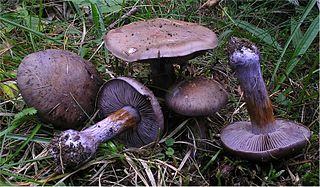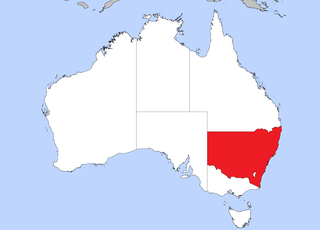
Cortinarius rubellus, commonly known as the deadly webcap, is a species of fungus in the family Cortinariaceae, native to high-latitude temperate to subalpine forests of Eurasia and North America. Within the genus it belongs to a group known as the Orellani, all of which are highly toxic—eating them results in kidney failure, which is often irreversible. The mushroom is generally tan to brown all over, with a conical to convex cap 2.5 to 8 centimetres in diameter, adnate gills and a 5.5 to 11 cm tall stipe.

Cortinarius is a globally distributed genus of mushrooms in the family Cortinariaceae. It is suspected to be the largest genus of agarics, containing over 2,000 widespread species. A common feature among all species in the genus Cortinarius is that young specimens have a cortina (veil) between the cap and the stem, hence the name, meaning curtained. Most of the fibres of the cortina are ephemeral and will leave no trace once gone, except for limited remnants on the stem or cap edge in some species. All have a rusty brown spore print. The common names cortinar and webcap refer to members of the genus. Due to dangerous toxicity of several species and the fact that it is difficult to distinguish between various species of the genus, non-expert consumption of mushrooms from the genus is discouraged.

The Cortinariaceae are a large family of gilled mushrooms found worldwide, containing over 2100 species. The family takes its name from its largest genus, the varied species of the genus Cortinarius. Many genera formerly in the Cortinariaceae have been placed in various other families, including Hymenogastraceae, Inocybaceae and Bolbitiaceae.

Cortinarius flexipes is a fungus, specifically a mushroom, a small brown species in the genus Cortinarius. It is commonly known as the Pelargonium webcap because of its unusual smell of Pelargonium.

Cortinarius triumphans, also known as the birch webcap, or yellow girdled webcap is a basidiomycete mushroom of the genus Cortinarius found in Europe. It is regarded as edible by some authorities, although others call it suspect and it resembles inedible species.

Cortinarius rotundisporus, also known as the elegant blue webcap, is a basidiomycete mushroom of the genus Cortinarius found in southern Australia, where it is found in eucalypt forests and rainforests. The cap of the fruit body is a steely blue colour, with a yellowish boss, and paler similarly coloured stipe.

Cortinarius violaceus, commonly known as the violet webcap or violet cort, is a fungus in the webcap genus Cortinarius native across the Northern Hemisphere. The fruit bodies are dark purple mushrooms with caps up to 15 cm (6 in) across, sporting gills underneath. The stalk measures 6 to 12 centimetres by 1 to 2 centimetres, sometimes with a thicker base. The dark flesh has a smell reminiscent of cedar wood. Forming symbiotic (ectomycorrhizal) relationships with the roots of various plant species, C. violaceus is found predominantly in conifer forests in North America and deciduous forests in Europe.

Cortinarius archeri is a species of mushroom in the genus Cortinarius native to Australia. The distinctive mushrooms have bright purple caps that glisten with slime, and appear in autumn in eucalypt forests.

Cortinarius traganus, also known as the gassy webcap, is a basidiomycete mushroom of the genus Cortinarius. The mushrooms are characterized by their lilac color, the rusty-brown gills and spores, and rusty-brown flesh in the stem.

Cortinarius purpurascens, also known as the bruising webcap, is a basidiomycete mushroom of the genus Cortinarius. The fruit bodies grow in groups on the ground in coniferous forests, throughout the temperate zone of the Northern Hemisphere, including Europe and North America.

Cortinarius vanduzerensis is a species of mushroom in the family Cortinariaceae. Described as new to science in 1972, it is known only from the Pacific Northwest region of North America, where it grows under conifers such as spruce, hemlock, and Douglas-fir. The fruit bodies of the fungus, or mushrooms, have a slimy dark chestnut-brown cap that becomes deeply radially grooved or corrugated in maturity, and reaches diameters of up to 8 cm (3.1 in). The gills on the underside of the cap are initially pinkish-buff before becoming pale brown when the spores mature. The stem is lavender, measuring 10–18 cm (3.9–7.1 in) long and 1–2 cm (0.4–0.8 in) thick. The mushroom produces a rusty-brown spore print, with individual spores measuring 12–14 by 7–8 micrometers. The edibility of the mushroom has not been determined, and it has been described as "much too slippery to be of value".

Cortinarius camphoratus, commonly known as the goatcheese webcap, is an agaric fungus in the family Cortinariaceae. The fungus is found in Europe and North America, where its fruit bodies (mushrooms) grow on the ground in a mycorrhizal association with spruce and firs in coniferous forests. Mushrooms are characterized by pale blue lilac colors when young, and a strong distinctive odor. Sources disagree as to the edibility of the mushroom, but they are generally not recommended for eating.

Cortinarius cinereoroseolus is a species of truffle-like fungus in the family Cortinariaceae. Found in New South Wales, Australia, the species was described as new to science in 2010.

Cortinarius nebulobrunneus is a species of truffle-like fungus in the family Cortinariaceae. Found in New South Wales, Australia, the species was described as new to science in 2010.

Cortinarius iodes, commonly known as the spotted cort or the viscid violet cort, is a species of agaric fungus in the family Cortinariaceae. The fruit bodies have small, slimy, purple caps up to 6 cm (2.4 in) in diameter that develop yellowish spots and streaks in maturity. The gill color changes from violet to rusty or grayish brown as the mushroom matures. The species range includes the eastern North America, Central America, northern South America, and northern Asia, where it grows on the ground in a mycorrhizal association with deciduous trees. The mushroom is not recommended for consumption. Cortinarius iodeoides, one of several potential lookalike species, can be distinguished from C. iodes by its bitter-tasting cap cuticle.

Cortinarius australiensis, commonly known as the skirt webcap, is a species of mushroom in the genus Cortinarius native to Australia and New Zealand. The white mushrooms appear in autumn and can grow very large, with their caps reaching 30 cm (12 in) in diameter.

Cortinarius kioloensis is a fungus native to Australia. It was described in 2009 by Alec Wood, and is related to the Northern Hemisphere species Cortinarius violaceus.
Cortinarius jenolanensis is a fungus native to Australia. It was described in 2009 by Alec Wood, from a specimen collected at the Jenolan Caves on 30 April 1988. It has also been recorded from Tidbinbilla Nature Reserve in the Australian Capital Territory.

Cortinarius sublargus is a species of fungus in the family Cortinariaceae native to Australia. It was described in 1928 by John Burton Cleland from the Mount Lofty Ranges. Cleland also described Cortinarius radicatus in 1933 from material collected in Willunga Hill, Waitpinga, Mount Lofty, Mount Compass, and Kinchina, Though Cleland regarded them as distinct, later authorities determined them to be the same species. The latter name turned out to be a homonym, having already been given to a different species.















